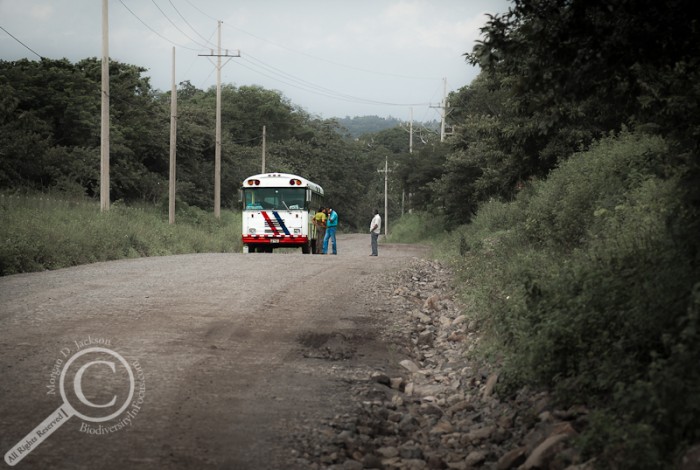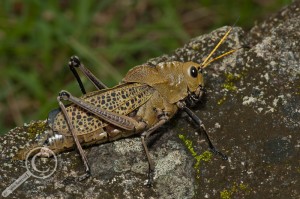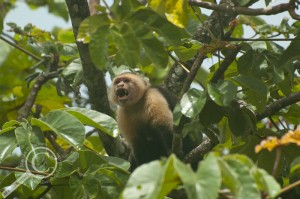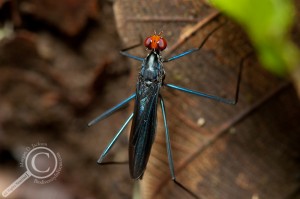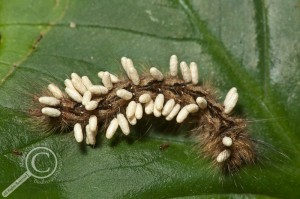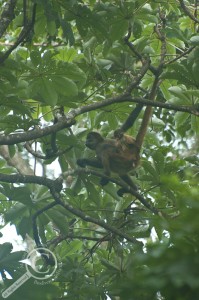With a full day’s collecting (as unproductive as it was) already under my belt, I’m ready for some dinner, and the cook staff at ACG provides the best meal of our visit; fried fish and purple salad, plus the ubiquitous rice and beans I take out of pure hunger. I finish my dinner in a hurry, as our next adventure will be beginning shortly; a trip to the beach searching for nesting sea turtles. Although the chances are low that we’ll actually witness an arribada, the opportunity to explore another region of this conservation area was all I needed to sign up. We’ve been warned that the rainy season is not the best time of year to even get to the beach, and it was pointed out that most surfers don’t bother trying to get there this time of year. I see this as an added bonus, the opportunity to get to an area almost devoid of human presence, a stark contrast to today’s “tourist trail”.
“Life’s a journey, not a destination” Aerosmith
I awake in time for a hurried breakfast before the bus departs for Rincon de la Veija, our destination for the day. Rice, beans and scrambled eggs again, so I choose some toast and cereal and sit off on my own to gain a moment of solitude before another long day. We soon load onto the school bus that’s delivered many a generation of child and which will hopefully last one more trip with us aboard. Settling into my seat, or what’s left of it, and enjoying the scenery of jungles, pastures, and forested volcanoes rising up to the clouds, I ignore the growing discomfort settling in my back from the aged seat. It seems the seats are not the only components lacking functionality, with each rock and bump being translated directly from the road to my body with little dampening as we turn onto the winding road up the mountain. The grasses introduced from Africa for cattle pasture roll on and on along the sides of the volcanoes, with vultures, iguanas, and flycatchers each choosing a fence post to admire the morning sun from. As I readjust in my seat to find a scrap of padding for the umpteenth time, the bus pulls to a halt and the driver jumps out without a word. As I watch from my seat while he looks under the bus and then down the road with a puzzled look, I decide that perhaps today marks the end for this decrepit vehicle. Apparently the transport boss and our local coordinator feel the same way and it isn’t long before they’ve joined the driver looking back down the road with concerned faces. Information trickles in now that the battery has fallen out of the bus somewhere along the road, but not to worry because we’ll keep on driving. A few turns more and the bus decides that in fact we won’t keep driving, coming to a silent stop and then rolling back down the mountain before the driver applies the brakes. I can’t help but laugh at the situation, but also wonder what happens next. It seems we’re within a short walk to the outer edges of the conservation property and that a new bus will be brought in shortly to take us up to our true destination. In the meantime, they say, we can collect and explore the stream meandering its way down the volcano, a welcome and unexpected break from the mechanical chiropractor misaligning my back.
I think the long days are starting to catch up with me, I couldn’t bring myself to get out of bed to go birdwatching this morning! The extra hour of sleep was well worth it though, and I enjoyed a simpler breakfast today of PB on toast and some cereal. We had the day to explore around the main ACG station, so myself, Joel G, Joel K, Andrew and Jeff journeyed to a picturesque overlook that also happens to be a nice, open hilltop. Of course it’s taped off for safety’s sake (the ladder up the side of the building seems to be falling out of the wall) but we didn’t attempt the full climb and just stuck around the base. The sun was fighting for some space today, but we had some pretty good luck when it did break through. Something that I hadn’t seen before was huge congregations of dragonflies floating up above where the flies and other insects were looking for a mate, seemingly feasting on the buffet of bugs. Easily 100 dragonflies were visible at any given time! Really the only exciting Diptera finds were some large robber flies (Asilidae), which were gladly claimed by the group of asilidologists back at camp, and a few rather large grasshoppers. Of course, by rather large I actually mean the length of my pointer finger…
Click to Enlarge
It wasn’t just insects at the top of the hill though, as we saw some soaring raptors, and had a visit from a large troop of white-headed capuchin monkeys (Cebus capucinus)…
The rain chased us off the hill shortly after, and we had a long, rainy afternoon to pin insects and rest up. After dinner a small group of us decided to go on a “short” night walk with the hopes of finding a snake or two. We didn’t find any snakes, but we did see a possum, a few nightjars, and a spectacled owl! It was pretty fun calling in the owl and patiently scanning the trees in the dark for signs of movement. Ultimately it sat right out in the open for us and I was even able to get a few record shots of it. A pair of Pacific screech owls back at the station, and we called it a night!
MTC…
Our day started early again at 5:45 to catch some birds prior to breakfast. I really wasn’t feeling the breakfast this morning, so a small meal and then we loaded the school bus to get to our day trip location. Today we went partially up a local volcano to the San Cristobal Research Station, one of the outposts for the every caterpillar project I mentioned yesterday. The road was rough and the bus shocks poor, so it was a bit of a bouncy ride, but almost as soon as we got out of the bus and into the station the sun came out and there were quite a few flies out and about. Perhaps I should correct myself, there were a lot of micropezids flying! Within minutes of entering the jungle we found a tree fall where some Scipopus-like flies were freshly emerging and pumping hemolymph into their wings. I can’t positively identify the species to genus, but it was great to get a glimpse into the possible larval habitat. As we walked through the forest, it seemed as if everytime we looked up there was another species and a different genus flying nearby. I believe I ended up with 9 or 10 species in 6 or 7 genera and a total of almost 30 specimens. A very productive day for me, with specimens contributed by several people from the group. The rains set in right as we came back for lunch, and unfortunately stayed in for the remainder of our time at the station. We left a little early and made our way back to the main ACG station where we’re staying and the sun was shining, so some of us ended up jumping off the bus and walking the final few kilometres back to the station looking for more flies. Unfortunately they seemed to have gone into hiding early tonight, so instead we did some birding and saw a number of interesting species including Crested Curacao, a large chicken like bird with a bright yellow beak and ornate head feathers. A cold shower to get rid of a day’s grime, a brief dinner, and I was pinning away with all my new material.
The bus was a little slow this morning, taking 2 hours to do what normally would take 45 minutes in a 4×4 truck apparently. It certainly gave us plenty of opportunities to enjoy the lack of legroom and shocks…
I had my first Coke since leaving for Costa Rica 2 weeks ago, and man was it good. So much for going cold turkey…
I’ve now seen 3 monkey species (howler, Geoffrey’s spider, and white faced capuchin), white-tailed deer (weird, I know), agouti, bats, a strange ground-hog like creature, and something rustling through the undergrowth like bugs bunny. Pretty good mammal list for a day’s work!
The unidentified genus:
MTC…
Today started good and early while we got our gear repacked to head to the northwestern region of the country to spend a few days in the Guanacaste Conservation Area. The tour bus picked the people from our hotel up shortly before 8, and after a minor detour back to pick up the forgotten, we were on our way north! Unfortunately I slept most of the way up, and when I wasn’t sleeping I was writing blog posts, but there were some rather remarkable landscapes and sections of habitat that we drove through. The most impressive was probably Rincon de la Vieja, an active volcano that reached high into the clouds and had some fantastic secondary outcroppings in the foreground. We stopped for lunch in Liberia, and fended off the honey bees (Africanized perhaps?) throughout the course of our buffet meal. We arrived at the Guanacaste Conservation Area around 2:30 and quickly got ourselves set up in our rooms and ready to jump into the jungle. Within minutes of leaving the main station we had seen 2 troops of white-faced spider monkeys, and a lone howler monkey hanging out in the tree tops. Although the clouds had rolled in and the tropical sun was starting to go down, we still had a number of interesting insect finds, if not flies. Dinner was pretty good, better than predicted at least, and we then sat down and introduced ourselves and pointed out which families we work on and which we’d like material, it was pinning any insects we may have found and some cards before bed. The station and habitat around here looks great, so it should be a really exciting week of collecting.
On the way back to the lodge we ran into Dan Janzen and Winnie Hallwachs, two big-time ecologists who are currently trying to identify every moth, skipper and butterfly within the conservation area using DNA barcoding. They had just run across a boa, which we couldn’t refind unfortunately, but hopefully we’ll see more in the next few days!
It wouldn’t be ACG without a heavily parasitized caterpillar:
And everybody likes monkeys!
Click to Enlarge
MTC…

